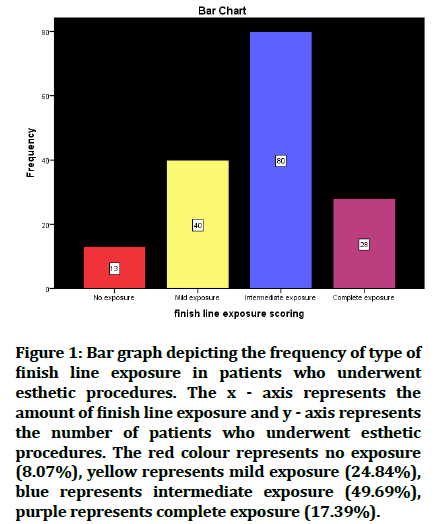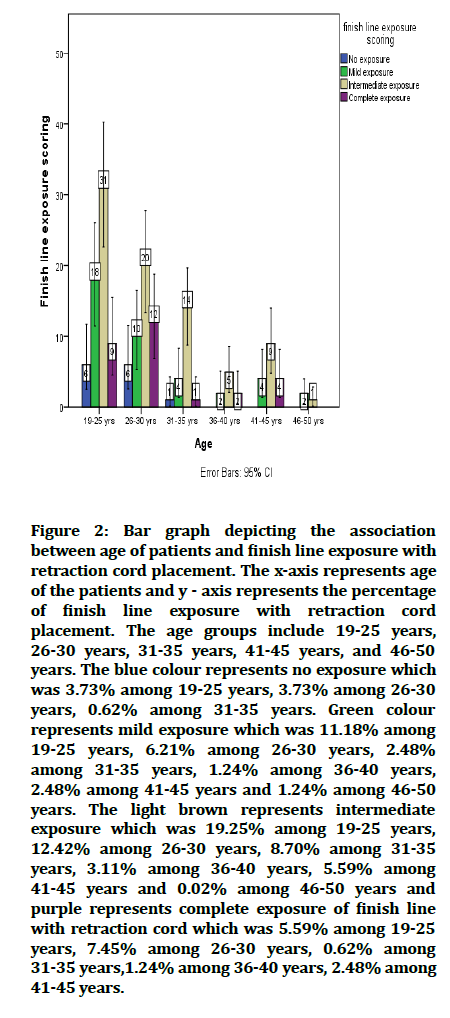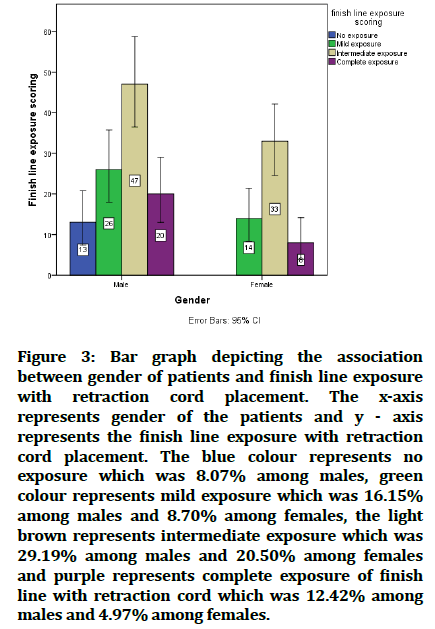Research - (2022) Volume 10, Issue 1
Evaluation of Finish Line Exposure with Retraction Cord Placement in Esthetic Procedures-A Retrospective Study
*Correspondence: Karthickraj SM, Department of Aesthetics, Saveetha Dental College and Hospitals, Saveetha Institute of Medical and Technical Sciences, Saveetha University, Chennai, India, Email:
Abstract
Finish line exposure has to be adequate during impression making. The goal of gingival retraction is to a traumatically displace gingival tissues to allow access for impression material to record the finish line and provide sufficient thickness of gingival sulcus so that the impression does not tear off during removal. Supra-gingival margins are effective in periodontal health maintenance, but do not provide optimal aesthetics. The current study aims at evaluation of finish line exposure with retraction cord placement in esthetic procedures in Saveetha dental college and hospitals from April 2020 to February 2021. Materials and Method: It is a single cantered retrospective study conducted in a private dental institution, Chennai. The data was collected from the dental hospital management system. The data included a varied population predominantly south Indian. All the details of the patients from April 2020 to Feb 2021 were collected. The internal validity included diagnosed cases as per criteria, medical history, chief complaints and clinical findings. Inclusion criteria include patients above age of 18, type of finish line and finish line exposure in patients who had undergone veneers. Exclusion criteria include presence of systemic disorders, type of material used for veneers. Results: In the current study, it was found that subjects aged 19 to 25 and 26 to 30 had superior finish line exposure with retraction cord placement than subjects of other ages, which was statistically significant and there was no statistically significant difference in finish line exposure with retraction cord positioning between males and females. Conclusion: Within study limits, it is concluded that intermediate exposure of the finish line was observed more in all the patients who underwent esthetic procedures.
Keywords
Finish line exposure, Retraction cord, Esthetic procedures, Novel technique, Innovative technique
Introduction
Only when the gingival tissue is adequately maintained can a precise impression be acquired for the manufacture of cemented restorations. This is especially true when the finish line is at, or within, the gingival sulcus, or while restoring a cervical lesion due to the gingival tissues' closeness.
Chemo mechanical (retraction cords), surgical (electro surgery), and mechanical finish-line exposure are the three most popular approaches (copper bands). Medications, which may be impregnated or soaked into the retraction cord, are frequently used to retract, displace, constrict, or reduce the gingival tissues [1]. One issue with this treatment is that the medication administered could have both local and systemic side effects. There have been several assessments of the literature on finish line exposure.
Marginal adaptation is influenced by four main factors: finish-line configuration, value of the cementing space, veneering process, and occurrence of cementation [2]. Whilst the other factors are out of the dentists’ control, the finishing-line configuration is, and although tooth preparation is part of daily routine, dentists often select the cervical finish line based on their experience and personal choice. In the era of minimally invasive dentistry, more conservative preparation geometries, such as chamfer, should be preferred than the rounded shoulder [2,3]. However, which finish line offers better marginal and internal adaptations is still not well defined.
During impression making, the finish line exposure must be sufficient. The purpose of gingival retraction is to a traumatically displace gingival tissues to allow access for impression material to record the finish line and to provide enough thickness of gingival sulcus to prevent the impression from tearing off during removal [4]. Supragingival margins are effective in maintaining periodontal health; however they are not ideal in terms of aesthetics. As a result, the margin of the restoration is usually set subgingival, especially in the aesthetics zone [5]. Our team has extensive knowledge and research experience that has translate into high quality publications [6-25].
The current study aims at evaluation of finish line exposure with retraction cord placement in esthetic procedures in Saveetha dental college and hospitals from April 2020 to February 2021.
Materials and Method
It is a single cantered retrospective study conducted in a private dental institution, Chennai. The data was collected from the dental hospital management system. Ethical clearance for this study was obtained from the Institutional review board.
The data included a sample size of 161, a varied population predominantly south Indian. All the details of the patients from April 2020 to feb 2021 were collected.
All the case sheets were reviewed and were cross verified by another examiner. The internal validity included diagnosed cases as per criteria, medical history, chief complaints and clinical findings.
Inclusion criteria include patients above age of 18, type of finish line and finish line exposure in patients who had undergone veneers. Exclusion criteria include presence of systemic disorders, type of material used for veneers.
The data collected was tabulated under following parameters: Age, gender, finish line exposure which was evaluated with photographs .
The independent variable includes age, gender and dependent variables include finish line exposure. The data analysis was performed using SPSS software of version 23.
The chi square test and pearson correlation was done. p value<0.05 was considered statistically significant.
Results and Discussion
Equigingival margins are not advised in the traditional sense because they are regarded to retain more plaque than supragingival or subgingival margins and hence produce more gingival inflammation.
It was also feared that even a minor recession might result in an ugly margin presentation.
A total of 161 patients were included in the study, with 64 being between the ages of 19 and 25, 48 being between the ages of 26 and 30, 20 being between the ages of 31 and 35, 9 being between the ages of 36 and 40, 17 being between the ages of 41 and 45, and three being between the ages of 46 and 50.
Figure 1 depicts intermediate exposure at 49.69 percent, mild exposure at 24.84 percent, complete exposure at 17.39 percent, and no exposure at 8.07 percent.
Figure 1: Bar graph depicting the frequency of type of finish line exposure in patients who underwent esthetic procedures. The x - axis represents the amount of finish line exposure and y - axis represents the number of patients who underwent esthetic procedures. The red colour represents no exposure (8.07%), yellow represents mild exposure (24.84%), blue represents intermediate exposure (49.69%), purple represents complete exposure (17.39%).
In the current study, it was found that subjects aged 19 to 25 and 26 to 30 had superior finish line exposure with retraction cord placement than subjects of other ages, which was statistically significant (p<0.05). Gingiva thickness was found to be thicker in the younger age group than in the older age group at both sites, i.e. midbuccal and interdental papilla [26,27]. The gingiva, on the other hand, was found to be thicker in the younger age group than in the older age group in a finding that could be due to changes in the oral epithelium caused by age, such as thinning of the epithelium and diminished keratinization.
The current study's findings show that there was no statistically significant difference in finish line exposure with retraction cord positioning between males and females (p>0.05). Female volunteers' gingival thickness was found to be thinner than male volunteers, similar to the findings of previous research.
These worries are no longer justified, not only because restoration margins can be blended in with the tooth for a more natural appearance, but also because restorations can be finished quickly to offer a smooth, polished interface at the gingival margin. Both supragingival and Equigingival margins are well tolerated from a periodontal perspective. When placing subgingival or Equigingival margins for finishing treatments, the highest biologic risk occurs, and if the margin is placed too much below the gingival tissue crest, the gingival attachment apparatus is violated. Restorative margins placed subgingival not only risk invading the attachment apparatus, but they also appear to cause undesirable tissue effects simply because of their subgingival placement, regardless of sulcus penetration depth. The limitations of the current study include single cantered study with limited population and can be used in future studies with large sample size (Figures 2-3).
Figure 2: Bar graph depicting the association between age of patients and finish line exposure with retraction cord placement. The x-axis represents age of the patients and y - axis represents the percentage of finish line exposure with retraction cord placement. The age groups include 19-25 years, 26-30 years, 31-35 years, 41-45 years, and 46-50 years. The blue colour represents no exposure which was 3.73% among 19-25 years, 3.73% among 26-30 years, 0.62% among 31-35 years. Green colour represents mild exposure which was 11.18% among 19-25 years, 6.21% among 26-30 years, 2.48% among 31-35 years, 1.24% among 36-40 years, 2.48% among 41-45 years and 1.24% among 46-50 years. The light brown represents intermediate exposure which was 19.25% among 19-25 years, 12.42% among 26-30 years, 8.70% among 31-35 years, 3.11% among 36-40 years, 5.59% among 41-45 years and 0.02% among 46-50 years and purple represents complete exposure of finish line with retraction cord which was 5.59% among 19-25 years, 7.45% among 26-30 years, 0.62% among 31-35 years,1.24% among 36-40 years, 2.48% among 41-45 years.
Figure 3: Bar graph depicting the association between gender of patients and finish line exposure with retraction cord placement. The x-axis represents gender of the patients and y - axis represents the finish line exposure with retraction cord placement. The blue colour represents no exposure which was 8.07% among males, green colour represents mild exposure which was 16.15% among males and 8.70% among females, the light brown represents intermediate exposure which was 29.19% among males and 20.50% among females and purple represents complete exposure of finish line with retraction cord which was 12.42% among males and 4.97% among females.
Conclusion
Within study limits, it is concluded that intermediate exposure of the finish line was observed more in all the patients who underwent esthetic procedures. And the finish line exposure was more prominent in young adults of age 19-30 years compared to older adults.
Conflict of Interest
No.
Acknowledgement
We would like to thank all the participants who took part in the study. We also thank Saveetha dental college and hospitals for their constant help and support.
Author Contribution
The first author (Inchara R) performed literature search, data collection, analysis, manuscript writing. The second author (Dr. Karthickraj SM) contributed study design, data verification and revised the manuscript.
Source of Funding
The present project is funded by Saveetha Institute of Medical and Technical Sciences, Saveetha Dental College and Hospitals, Saveetha University, Chennai, India
Rakshith homes pvt. ltd.
References
- https://muse.jhu.edu/article/694556
- Ranganathan H, Ganapathy DM, Jain AR. Cervical and incisal marginal discrepancy in ceramic laminate veneering materials: A SEM analysis. Contemporary Clin Dent 2017; 8:272.
- Peris H, Godoy L, Cogolludo PG, et al. Ceramic veneers on central incisors without finish line using bopt in a case with gingival asymmetry. J Clin Exp Dent 2019; 11:e577â??81.
- Euán R, Figueras-Ãlvarez O, Cabratosa-Termes J, et al. Comparison of the marginal adaptation of zirconium dioxide crowns in preparations with two different finish lines. J Prosthodont. 2012; 21:291â??5.
- Sachs M. Missing the finish line. Ps yc Critiques 2015; 60.
- Muthukrishnan L. Imminent antimicrobial bioink deploying cellulose, alginate, EPS and synthetic polymers for 3D bioprinting of tissue constructs. Carbohydr Polym 2021; 260:117774.
- PradeepKumar AR, Shemesh H, Nivedhitha MS, et al. Diagnosis of vertical root fractures by cone-beam computed tomography in root-filled teeth with confirmation by direct visualization: A systematic review and meta-analysis. J Endod 2021; 47:1198â??214.
- Chakraborty T, Jamal RF, Battineni G, et al. A review of prolonged post-COVID-19 symptoms and their implications on dental management. Int J Environ Res Public Health 2021; 18.
- Muthukrishnan L. Nanotechnology for cleaner leather production: A review. Environ Chem Lett. 2021; 19:2527â??49.
- Teja KV, Ramesh S. Is a filled lateral canal-A sign of superiority? J Dent Sci 2020; 15:562â??3.
- Narendran K, Jayalakshmi, Ms N, Sarvanan A, et al. Synthesis, characterization, free radical scavenging and cytotoxic activities of phenylvilangin, a substituted dimer of embelin. Indian J Pharm Sci 2020; 82.
- Reddy P, Krithikadatta J, Srinivasan V, et al. Dental caries profile and associated risk factors among adolescent school children in an Urban South-Indian City. Oral Health Prev Dent 2020; 18:379â??86.
- Sawant K, Pawar AM, Banga KS, et al. Dentinal microcracks after root canal instrumentation using instruments manufactured with different NiTi alloys and the SAF system: A systematic review. Adv Sci Inst Ser E Appl Sci 2021; 11:4984.
- Bhavikatti SK, Karobari MI, Zainuddin SLA, et al. Investigating the antioxidant and cytocompatibility of Mimusops elengi linn extract over human gingival fibroblast cells. Int J Environ Res Public Health 2021; 18.
- Karobari MI, Basheer SN, Sayed FR, et al. An in vitro stereomicroscopic evaluation of bioactivity between neo MTA Plus, Pro Root MTA, Biodentine & glass ionomer cement using dye penetration method. Materials. 2021; 14.
- Rohit Singh T, Ezhilarasan D. Ethanolic extract of lagerstroemia speciosa (L.) pers., induces apoptosis and cell cycle arrest in HepG2 cells. Nutr Cancer 2020; 72:146â??56.
- Ezhilarasan D. MicroRNA interplay between hepatic stellate cell quiescence and activation. Eur J Pharmacol 2020; 885:173507.
- Romera A, Peredpaya S, Shparyk Y, et al. Bevacizumab biosimilar BEVZ92 versus reference bevacizumab in combination with FOLFOX or FOLFIRI as first-line treatment for metastatic colorectal cancer: a multicentre, open-label, randomised controlled trial. Lancet Gastro Hepatol 2018; 3:845â??55.
- Raj RK. Ã?-Sitosterol-assisted silver nanoparticles activates Nrf2 and triggers mitochondrial apoptosis via oxidative stress in human hepatocellular cancer cell line. J Biomed Mater Res A 2020; 108:1899â??908.
- Vijayashree Priyadharsini J. In silico validation of the non-antibiotic drugs acetaminophen and ibuprofen as antibacterial agents against red complex pathogens. J Periodontol 2019; 90:1441â??8.
- Priyadharsini JV, Vijayashree Priyadharsini J, Smiline Girija AS, et al. In silico analysis of virulence genes in an emerging dental pathogen A. baumannii and related species. Arch Oral Biology 2018; 94:93â??8.
- Uma Maheswari TN, Nivedhitha MS, Ramani P. Expression profile of salivary micro RNA-21 and 31 in oral potentially malignant disorders. Braz Oral Res 2020; 34:e002.
- Gudipaneni RK, Alam MK, Patil SR, et al. Measurement of the maximum occlusal bite force and its relation to the caries spectrum of first permanent molars in early permanent dentition. J Clin Pediatr Dent. 2020; 44:423â??8.
- Chaturvedula BB, Muthukrishnan A, Bhuvaraghan A, et al. Dens invaginatus: A review and orthodontic implications. Br Dent J 2021; 230:345â??50.
- Kanniah P, Radhamani J, Chelliah P, et al. Green synthesis of multifaceted silver nanoparticles using the flower extract of Aerva lanata and evaluation of its biological and environmental applications. Chemistry Select 2020; 5:2322â??31.
- Müller H-P, Heinecke A, Schaller N, et al. Masticatory mucosa in subjects with different periodontal phenotypes. J Clin Periodontol 2000; 621â??626.
- Reddy S. Essentials of clinical periodontology and periodontics. 2011.
Indexed at, Google Scholar, Cross Ref
Indexed at, Google Scholar, Cross Ref
Indexed at, Google Scholar, Cross Ref
Indexed at, Google Scholar, Cross Ref
Indexed at, Google Scholar, Cross Ref
Indexed at, Google Scholar, Cross Ref
Indexed at, Google Scholar, Cross Ref
Indexed at, Google Scholar, Cross Ref
Indexed at, Google Scholar, Cross Ref
Indexed at, Google Scholar, Cross Ref
Indexed at, Google Scholar, Cross Ref
Indexed at, Google Scholar, Cross Ref
Indexed at, Google Scholar, Cross Ref
Indexed at, Google Scholar, Cross Ref
Indexed at, Google Scholar, Cross Ref
Indexed at, Google Scholar, Cross Ref
Indexed at, Google Scholar, Cross Ref
Indexed at, Google Scholar, Cross Ref
Indexed at, Google Scholar, Cross Ref
Indexed at, Google Scholar, Cross Ref
Author Info
Department of Aesthetics, Saveetha Dental College and Hospitals, Saveetha Institute of Medical and Technical Sciences, Saveetha University, Chennai, IndiaCitation: Inchara R, Karthickraj SM, Evaluation of Finish Line Exposure with Retraction Cord Placement in Esthetic Procedures-A Retrospective Study , J Res Med Dent Sci, 2022, 10(1): 177-180
Received: 12-Dec-2021, Manuscript No. JRMDS-21-47246; , Pre QC No. JRMDS-21-47246 (PQ); Editor assigned: 14-Dec-2021, Pre QC No. JRMDS-21-47246 (PQ); Reviewed: 28-Dec-2021, QC No. JRMDS-21-47246; Revised: 03-Dec-2021, Manuscript No. JRMDS-21-47246 (R); Published: 07-Jan-2022



